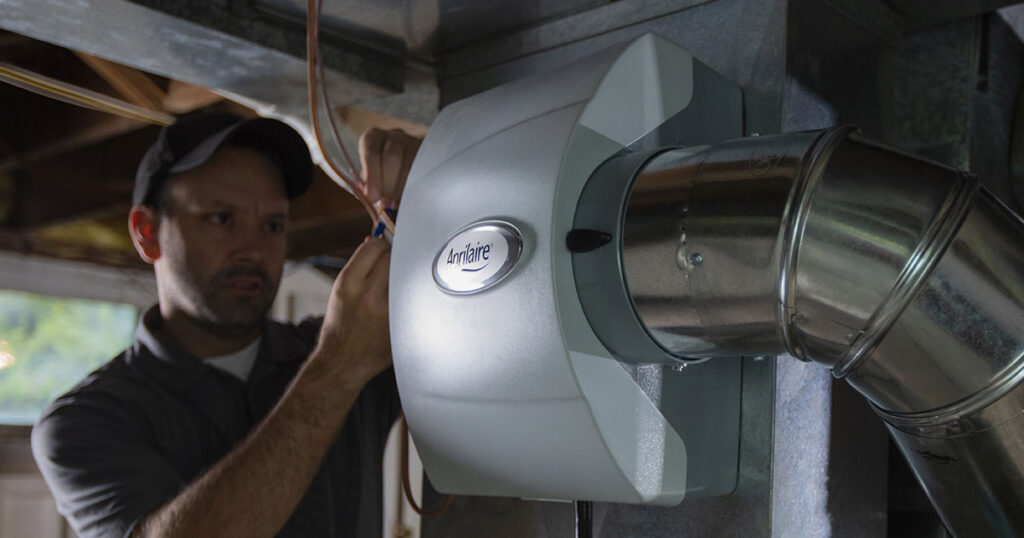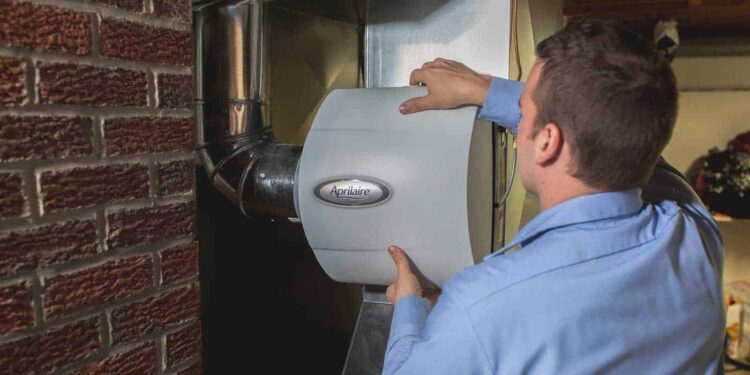Humidifiers help to raise humidity levels in buildings and residences, resulting in the desired level of moisture in the air. While there are standalone humidifiers on the market that can do this in a single room, central humidifiers are connected to a home’s plumbing and heating systems and perform significantly better.
What is a Central Air Humidifier?
A humidifier is a piece of equipment that uses water vapor to moisten the air. These devices are usually available in portable, desktop, or console models that can be used to humidify a single room or area.
A central humidifier, on the other hand, is hardwired into your home’s heating and air conditioning unit and then connected to the plumbing. Rather than functioning on a single point of use (bedroom, kitchen, or bathroom), these permanent systems humidify the entire house at the same time, making them exceptionally efficient in terms of efficacy, conservation, and cost savings.
ProTip Takeaway: The humidistat is an element of the HVAC system that controls humidity, comparable to a thermostat. The humidistat regulates the amount of moisture in the air, allowing your humidification system to efficiently manage the humidity level in your building.
Types of Humidifiers
Steam humidifier
This type works by electrically heating water to create steam and, as a result, humidity. The steam is then circulated throughout the house or building through the system.

Steam humidifiers are the most effective and efficient way to keep your home at the right humidity level. Steam humidifiers also deliver the purest type of humidity and moisture, regardless of the heating/cooling system.
Drum-Type Humidifier
This design is less expensive, but it also requires more care. It is made out of a revolving drum with a spongy absorbent surface that collects water from an underlying tray. The air circulates and flows through the moist, porous sponge when the central heating system is turned on increasing humidity.

During the winter months, most manufacturers recommend cleaning the water tray and drum surface to eliminate stagnant water and avoid mold and bacteria growth.
Trickle (or flow-through) Humidifier
A humidifier with a trickle (or flow-through) design allows freshwater to trickle into a metal panel that air travels through, creating water vapor. Any residual water is drained away through a drainage tube, leaving no standing water. While more expensive than the drum-type, this “self-cleaning” design feature requires less maintenance and reduces pathogen risk.

Portable/ Standalone Humidifier

This type benefits someone who is unwell or has allergies because it can be easily transported from room to room. It is also ideal for people who live in homes without central air conditioning. Also works well in smaller homes or apartments.
Advantages of a Central Air Humidifier
Let’s take a look at how a central air humidifier might help a home or business.
Enhanced Comfort
There will be balanced moisture throughout the house with suitable indoor humidity levels. As a result, common dry weather issues such as nosebleeds, dry eyes, itchy skin, and so on will be avoided.
Improved Health
The spread of colds might be aided by low humidity levels. A drier environment might encourage the spread of harmful diseases, but a central air humidifier can assist with this.
Saves time and money
When you use a humidifier unit, you may maintain your thermostat on a lower setting, which saves money. Lower your thermostat throughout the winter months to save energy on heating.
Easy to use and maintain
A central humidifier doesn’t require as much maintenance as portable devices. Because the water supply is connected to your plumbing, you won’t have to refill it. Plus, unlike console models, they don’t have a supply tank of standing water, so there’s less possibility of bacteria building up and spreading into the air.
Cost of a Central Air Humidifier
Central humidifiers are quite affordable when compared to the health and comfort benefits they provide. The price, however, is determined by the style and capacity. The national average for a central air humidifier is between $400 and $1,200. The most expensive one will cost you $2,200.
Drum types are the least expensive, with prices ranging from $150 to $250. Flow-through might cost anything between $200 and $300. A steam humidifier, the most common form, can cost anywhere from $300 to $1,500.
How to Maintain Central Humidifiers?
Humidifiers can significantly enhance the air quality in your home or place of work. Routine maintenance and repairs, as with any piece of equipment, are critical to its performance and lifespan.

The following are some humidifier maintenance recommendations.
- Some humidifiers contain a damper that closes off the duct opening. When not in use, make sure the damper is closed during the summer.
- If your humidifier is built into the furnace, it’s critical to check for leaks before turning it on. Even a little water leak can create corrosion and restrict adequate ducting airflow.
- Humidifiers are controlled by a humidistat that adjusts to the outside temperature. This may need to be done on a daily basis, depending on the unit’s design and manufacturer instructions; otherwise, the humidifier will over-saturate the air and generate condensation.







